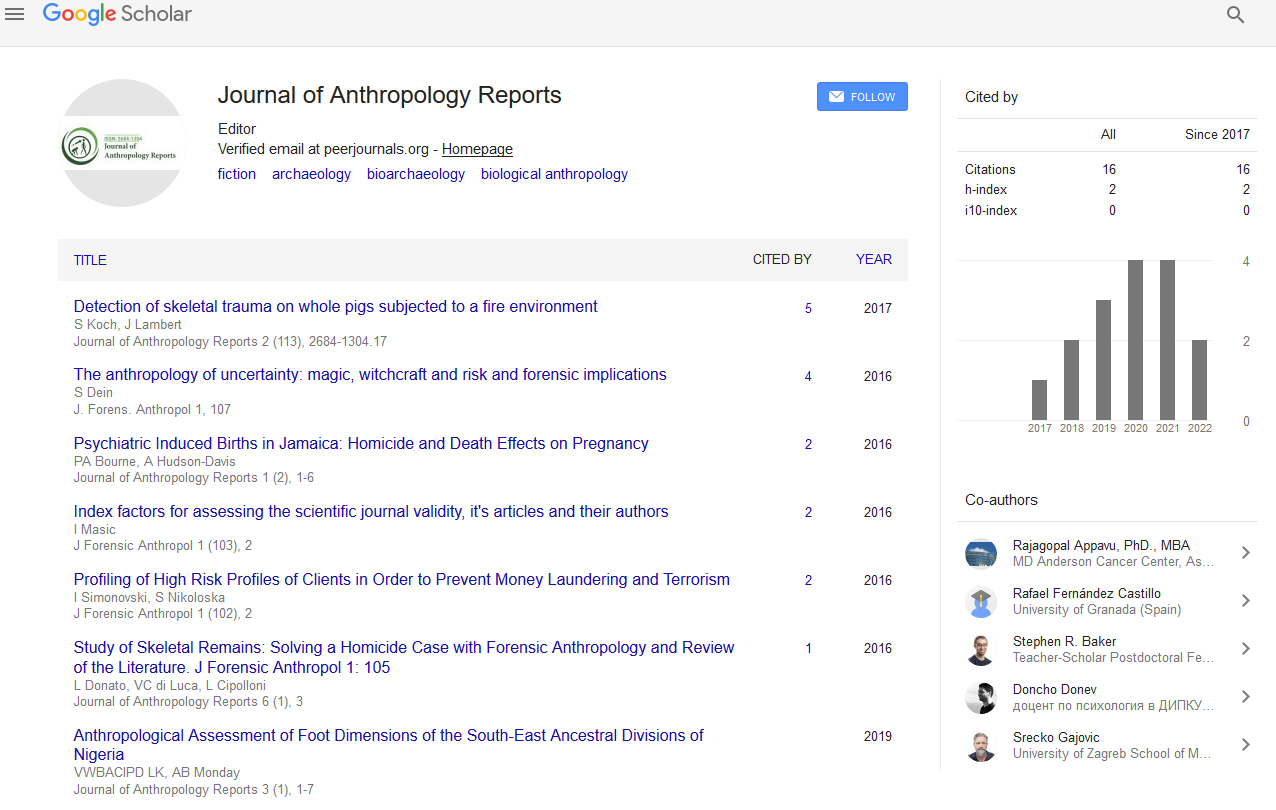Indexed In
- RefSeek
- Hamdard University
- EBSCO A-Z
Useful Links
Share This Page
Journal Flyer

Open Access Journals
- Agri and Aquaculture
- Biochemistry
- Bioinformatics & Systems Biology
- Business & Management
- Chemistry
- Clinical Sciences
- Engineering
- Food & Nutrition
- General Science
- Genetics & Molecular Biology
- Immunology & Microbiology
- Medical Sciences
- Neuroscience & Psychology
- Nursing & Health Care
- Pharmaceutical Sciences
Commentary - (2023) Volume 6, Issue 3
Forensic Archaeology's Microscopic Detectives: The Role of Trace Evidence Analysis
Harte Cassella*Received: 04-Sep-2023, Manuscript No. JFA-23-23409; Editor assigned: 06-Sep-2023, Pre QC No. JFA-23-23409 (PQ); Reviewed: 20-Sep-2023, QC No. JFA-23-23409 (QC); Revised: 27-Sep-2023, Manuscript No. JFA-23-23409 (R); Published: 06-Oct-2023, DOI: 10.35248/2684-1304.23.6.170
Description
Forensic archaeology is a specialized field within forensic science that focuses on the recovery, analysis, and interpretation of physical evidence from archaeological contexts. Unlike traditional crime scene investigation, forensic archaeologists are tasked with uncovering evidence from historical or ancient sites. One significant aspect of this work is the recovery of trace evidence, which can provide valuable insights into past events.
Trace evidence refers to tiny fragments or residues that are often invisible to the naked eye but can be of immense value in forensic investigations. This category includes a wide range of materials, such as fibers, hair, paint, glass, soil, pollen, gunshot residue, and even minute biological materials like skin cells. The significance of trace evidence lies in its ability to connect individuals, objects, or locations to a specific place or event, potentially linking a suspect to a crime scene or victim.
The role of trace evidence in forensic archaeology
In forensic archaeology, trace evidence plays a pivotal role in reconstructing past events. Whether excavating an ancient burial site or a historical crime scene, the recovery and analysis of trace evidence can provide critical information that traditional archaeological techniques alone may not reveal. Here's how trace evidence contributes to the forensic archaeologist's toolbox:
Contextual clues: Trace evidence found in archaeological layers can help establish the chronology of events, suggesting the sequence of actions that occurred at a site. For example, the presence of specific fabrics or dyes may indicate trade or contact with distant cultures.
Human identification: Human remains are often discovered in forensic archaeology, and trace evidence such as hair, clothing fibers, and personal items can help identify individuals or provide information about their lifestyles, social status, or origins.
Environmental context: Soil composition, pollen, and plant material recovered from an archaeological site can offer insights into the environment at the time of the event. This information can be used to understand factors such as climate, vegetation, and land use.
Reconstruction of crimes: Trace evidence, such as firearm discharge residue or tool marks, can help reconstruct the mechanisms of past crimes. These clues can be used to determine the type of weapon used, the distance of the shot, or the manner in which an object was altered.
Methods of trace evidence recovery
The recovery of trace evidence in forensic archaeology requires a systematic and meticulous approach. Archaeologists use a combination of traditional excavation techniques and specialized tools to collect these delicate materials without contamination. Some common methods include:
Troweling and sieving: Archaeologists use small trowels to carefully excavate layers of soil or sediment, and the material collected is then passed through fine-mesh sieves. This process helps separate trace evidence like fibers, hair, or small fragments from the surrounding debris.
Vacuuming and swabbing: In some cases, trace evidence may be present on surfaces or within crevices. Vacuuming and swabbing are non-destructive techniques that allow archaeologists to collect trace materials from such areas.
Use of specialized equipment: Forensic archaeologists often employ specialized equipment, such as microscopes, stereomicroscopes, and lasers, for the precise collection of trace evidence. These tools ensure minimal disturbance to fragile materials.
Protective gear: To prevent contamination, archaeologists wear gloves, lab coats, and masks when handling trace evidence. Clean containers are used for storing collected materials to maintain their integrity.
Trace evidence recovery in forensic archaeology is a detailed and vital aspect of complex understandings from the past. It offers valuable insights into historical events, human identities, and environmental conditions. The methods and techniques employed by forensic archaeologists enable them to gather these minuscule clues without compromising their integrity, ultimately contributing to the comprehensive understanding of past events. As technology and forensic science continue to advance, the role of trace evidence in forensic archaeology will undoubtedly become even more critical in solving historical puzzles and uncovering hidden truths.
Citation: Cassella H (2023) Forensic Archaeology's Microscopic Detectives: The Role of Trace Evidence Analysis. J Anthropol Rep. 6:170.
Copyright: © 2023 Cassella H. This is an open-access article distributed under the terms of the Creative Commons Attribution License, which permits unrestricted use, distribution, and reproduction in any medium, provided the original author and source are credited.

